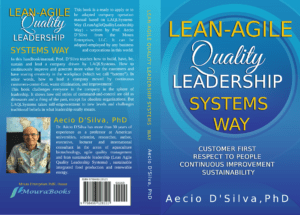Contents
- 1 How to Successfully Implement LAQL Way Management in Your Organization
- 2 By Aécio D’Silva, PhD(1), Maécia Moura, MSc(2), Fabiano Moura, MSc(3)
- 3 Lean-Agile Quality Leadership Intelligent Management – Step 1: Create a Sense of Urgency
- 4 Lean-Agile Quality Leadership Intelligent Management – Step 2: Build a Coalition of Support
- 5 Step 3: Develop a Vision, Mission, and Strategic Objectives
- 6 Step 4: Communicate the Change
- 7 Step 5: Empower Employees
How to Successfully Implement LAQL Way Management in Your Organization
By Aécio D’Silva, PhD(1), Maécia Moura, MSc(2), Fabiano Moura, MSc(3)
(1) Moura Enterprises, AquaUniversityTucson, AZ 85742, EUA; (2) Signature Dental Partners, Fênix, AZ 85008; (3) Profound Commerce, Inc. Austin, TX 78746.
Are you looking to improve the efficiency, productivity, and profitability of your company and business? Intelligent Lean-Agile Quality Leadership Management – LAQL – can help you achieve this faster, more sustainable, and more safely. In this post, we will guide you through a step-by-step change model to successfully implement LAQL Intelligent management in your organization.
Lean-Agile Quality Leadership Intelligent Management (LAQL Way) is a technology that integrates Quality, Lean, and Agile principles and focuses on creating value and quality for customers, continuing improvement, and doing it right with quality the first time by charging, reducing waste, and maximizing efficiency. It has been successfully implemented in many organizations, resulting in significant improvements in productivity, profitability, and customer satisfaction. However, implementing LAQL management requires planning, persistence, and a strong decision to change to make it work. In this post, we will provide a step-by-step change model to implement changes in LAQL Smart management in your organization/business.
Lean-Agile Quality Leadership Intelligent Management – Step 1: Create a Sense of Urgency
To successfully implement LAQL Way management, you must first create a sense of urgency among your employees. This means helping them understand why the change is necessary and how it will benefit the organization. You can do this by sharing data that highlights the inefficiencies and waste in the current system, and by demonstrating how LAQL Way management can address these issues.
Start by sharing the results of a comprehensive analysis of your organization’s processes and systems. Identify areas of waste, inefficiency, and duplication of effort. Share this data with your employees and explain how LAQL Way management can address these issues. Make it clear that implementing LAQL Way management is not an optional change, but a necessary step toward achieving the organization’s goals.
Lean-Agile Quality Leadership Intelligent Management – Step 2: Build a Coalition of Support
Once you have created a sense of urgency, the next step is to build a coalition of support. You need to identify key participants who can help you champion the change and get buy-in from the rest of the organization. These participants should include both senior leaders and front-line employees.
Identify the key participants who can help you drive the change. These participants should be influential individuals who have the ability to influence others and help you get buy-in from the rest of the organization. You should also identify employees who are likely to resist the change and work with them to address their concerns and build their support.
Step 3: Develop a Vision, Mission, and Strategic Objectives
The third step is to develop a Vision, Mission, and Strategic for implementing LAQL management. This involves defining your goals, identifying the resources you need, and creating a roadmap for achieving your objectives.
Define your goals and objectives for implementing LAQL management. These should be specific, measurable, achievable, relevant, and time-bound (SMART). Identify the resources you need to achieve these goals, such as training, technology, and support from external consultants. Create a roadmap that outlines the key steps and milestones for implementing lean management.
Step 4: Communicate the Change
The fourth step is to communicate the change to the rest of the organization. This involves creating a clear and compelling message about why the change is necessary, what it entails, and how it will benefit employees and the organization as a whole.
Create a clear and compelling message about the change. This message should explain why the change is necessary, what it entails, and how it will benefit employees and the organization as a whole. Use multiple communication channels to reach all employees, including meetings, emails, intranet posts, and newsletters. Provide opportunities for employees to ask questions and share their concerns.
Step 5: Empower Employees
The fifth step is to empower employees to participate in the change process. This involves providing them with the tools, resources, and training they need to effectively implement LAQL.
Empowering employees is a key element of successful LQLS Intelligent management implementation. By involving employees in the process, organizations can tap into the knowledge and experience of their workforce, leading to better outcomes and greater buy-in.
One way to empower employees is to provide training on LAQL Way principles and tools. This not only helps employees understand the goals of the implementation but also gives them the skills and knowledge needed to make improvements. Training can also help to build enthusiasm and excitement for the changes ahead.
Another way to empower employees is to involve them in the planning and implementation process. This can be done through the formation of cross-functional teams, which bring together employees from different departments to work on specific projects. By involving employees in this way, they are able to provide valuable insights and ideas, leading to better outcomes and a greater sense of ownership over the changes.
In addition to training and involvement, it is important for organizations to create a culture of continuous improvement. This means creating an environment where employees feel comfortable sharing their ideas and suggestions for improvement. By valuing employee input and involving them in the improvement process, organizations can create a culture of engagement and ownership.
In other words, empowering employees is critical to the success of LQLS Intelligent management implementation. By providing training, involving employees in the planning and implementation process, and creating a culture of continuous improvement, organizations can tap into the knowledge and experience of their workforce, leading to better outcomes and greater buy-in.
To conclude, LAQL management is a powerful methodology that can help organizations improve efficiency, productivity, and profitability. To help your business successfully implement LAQL Intelligent management, this step-by-step change model can be used. By creating a sense of urgency, building a coalition of support, developing a vision, mission, and strategic objectives, communicating the change, and empowering employees, organizations can improve efficiency, productivity, and profitability through Lean-Agile Quality Leadership Management (LAQL Way) management.
References:
- This Step-by-Step Change Model for Implementing LAQL is part of my book Lean-Agile Quality Leadership Way (Innovative, Intelligent and Sustainable Quality Lean-Agile Business Management for Successful Leaders) which is due to be released in Portuguese, Spanish, and French very soon. It is currently only available in English.







This is useful information especially for new businesses…Thank You for this opportunity of resource.